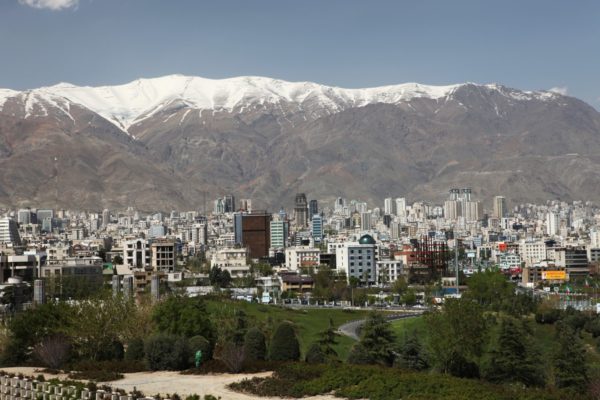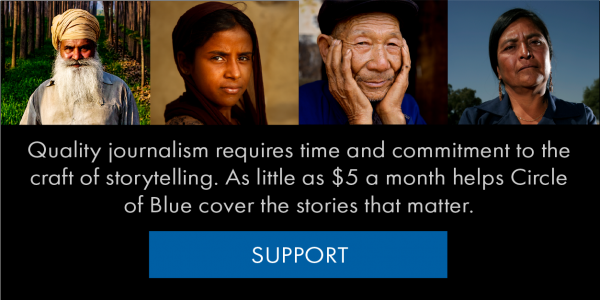Tehran, the capital and largest city, could soon be the epicenter of Iran’s water crisis.

Tehran. Photo courtesy of Ninara/Flickr Creative Commons.
Iran is on the fast track to severe water scarcity. The semi-arid country faces an onslaught of threats to its water supply, including climate change, population growth, mass migration, political instability, and resource mismanagement.
Tehran, the capital and largest city, could soon be the epicenter of the country’s water crisis. The city has grown rapidly in recent decades, its population now near 8.5 million. As Iran’s rural areas exhaust their water resources, Tehran is expected to grow even more.
“If water consumption for agriculture remains at this level, in less than 25 years Iran’s eastern and southern areas will be completely deserted, and 50 million people will have to emigrate,” Issa Kalantari, head of the Iranian Environment Department, warned in December 2017. Currently, 70 percent of Iranians live in urban areas. In the future, 80 percent are expected to live in cities.
Adding more residents would increase the pressure on a city where water use already is excessive. The city’s per capita water use exceeds 400 liters each day, compared with a country-wide average of 250 liters per day.
If this continues, Tehran’s water demand is estimated to be 1290 million cubic meters (MCM) per year by 2026. At that level, the city’s supply would be an estimated 100 MCM below demand in dry years.
“Water consumption has increased at a shocking rate in the city and in the province of Tehran,” Nematollah Torki, the head of Tehran’s Management and Planning Organization, reportedly told the Iranian Labour News Agency. “Imprudent use of the dwindling resource will lead to water crises.”
Torki noted that annual precipitation in Tehran province has decreased by 50 percent in recent years.
Tehran’s water supply is diminished by other factors as well, including desertification, climate change, and wasteful water practices. Illegal wells are a problem, too–officials estimate that nearly three-quarters of the wells in Tehran province do not have permits.
A Finite Resource
Changes in water availability are reflected in the country’s physical geography. Lake Urmia, once the largest salt lake in the Middle East, has shrunk to 5 percent of its previous size. Other waterways across the country have run dry as well. Scores of illegal wells, plus heavy agricultural use, are depleting groundwater.
“In less than 50 years, we’ve used all but 30 percent of our groundwater supply, which took a million years to gather, and it’s getting worse and worse due to unsustainable development,” explained Nasser Karami, an Iranian physical climatologist, in an interview with the Washington Post.
In 2013, a study by the World Resources Institute named Iran the 24th most water-stressed nation. The grim ranking means that the country is at high risk of future water scarcity.
“Iran’s 8,000-year-old civilization will be destroyed if the level of our water consumption is not reduced,” Issa Kalantari, the country’s environmental department head, admonished last year.
As the scope of Iran’s water crisis becomes clear, officials in Tehran are encouraging sustainable water use. In addition to educating citizens about the consequences of waste, Tehran has threatened water rationing if residents fail to cut consumption.
A 2014 study, authored by a team of Iranian scientists, offers a handful of solutions to Tehran’s crisis. The researchers argue that water reuse and wastewater recycling are both feasible and affordable. They suggest that recycled water could be used in parks, industrial plants, and other places that do not require high-quality water.
Resources And Further Reading
Iran’s Water Crisis Passes Tipping Point (Radio Farda)
Iran’s water crisis the product of decades of bad planning (The Washington Post)
Tehran Residents Warned Again About Water Consumption (Financial Tribune)
Water reuse and wastewater recycling- Solutions to Tehran’s growing water crisis (Research Gate)
Water reuse in Iran with an emphasis on potable reuse (Scientia Iranica)
Kayla Ritter is a recent graduate of Michigan State University, where she studied International Relations and Teaching English to Speakers of Other Languages. She is currently based in Manton, Michigan. Kayla enjoys running, writing, and traveling. Contact Kayla Ritter



